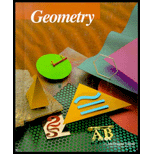
Concept explainers
Write always, sometimes , or never to complete the statement.
Answer to Problem 8CUR
Sometimes.
Explanation of Solution
Given:
Given a plane containing points A and B , the locus of points in the plane that are equidistant from A and B and are 10 cm from A is __ one point.
Calculation:
The locus of all the points that are equidistant from A and B is the perpendicular bisector of the line segment AB.
If the distance between A and B is 20 cm, then the mid point is equidistant from A and B , and is 10 cm from A , which is one point.
But it is not always true.
If a point on the perpendicular bisector to the line segment AB is 10 cm from A , then it will be 10 cm apart from B as well.
Also, the mirror image of that point on the perpendicular bisector , taking AB as a mirror , will as be equidistant from A and B , and 10 cm apart from A.
So, the statement can be filled as :
Given a plane containing points A and B , the locus of points in the plane that are equidistant from A and B and are 10 cm from A is sometimes one point.
Chapter 10 Solutions
McDougal Littell Jurgensen Geometry: Student Edition Geometry
Additional Math Textbook Solutions
College Algebra with Modeling & Visualization (5th Edition)
Thinking Mathematically (6th Edition)
Precalculus
Elementary Statistics
A Problem Solving Approach To Mathematics For Elementary School Teachers (13th Edition)
Pre-Algebra Student Edition
 Elementary Geometry For College Students, 7eGeometryISBN:9781337614085Author:Alexander, Daniel C.; Koeberlein, Geralyn M.Publisher:Cengage,
Elementary Geometry For College Students, 7eGeometryISBN:9781337614085Author:Alexander, Daniel C.; Koeberlein, Geralyn M.Publisher:Cengage, Elementary Geometry for College StudentsGeometryISBN:9781285195698Author:Daniel C. Alexander, Geralyn M. KoeberleinPublisher:Cengage Learning
Elementary Geometry for College StudentsGeometryISBN:9781285195698Author:Daniel C. Alexander, Geralyn M. KoeberleinPublisher:Cengage Learning

